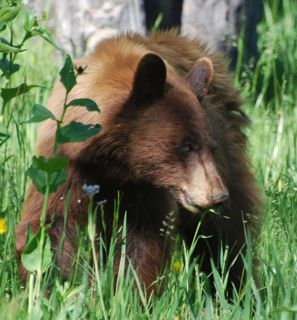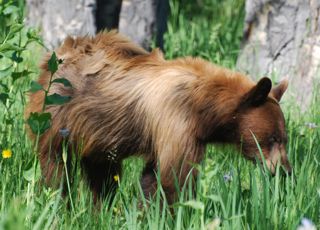 “Bear are made of the same dust as we, breath the same winds, and drink of the same waters…” John Muir
“Bear are made of the same dust as we, breath the same winds, and drink of the same waters…” John Muir
I am an admitted ursophile (and I am not ashamed, Stephen Colbert!). As a young girl, I would gaze at wildlife encyclopedias with longing, and always dreamed of seeing grizzlies, black bears, polar bears, et al.
Bears frolic in large numbers over Yellowstone’s landscape, and my dreams have been realized—ten times over! I am in awe of being in such close proximity to these wondrous creatures, and it’s a rare week when I don’t see a bear.
Grizzly and black bears roam in Yellowstone—yet I’m not adept at quickly telling the difference between the two species. This beautiful young bear I saw munching on grass outside of Mammoth Hot Springs has large pointed ears, a flat nose in profile, and no distinct hump (yet the ruffled fur made it hard to tell)—all of which indicate a black bear. But as even the experts sometimes have a difficult time distinguishing between ursus americanus and ursus arctos horribilis, I would not rely on my judgment. Any bear experts out there—please advise if I chose wrongly.
 Both bear species can live up to 30 years. About 150 grizzlies live in the park, as compared with 500 black bears. An adult grizzly, despite their bulky size (males weigh up to 700 lbs) might be seen running at a speed of 40 mph. Bears have a very diverse diet ranging from insects, to grasses, to trout. Both black bear and grizzlies also hunt and have been know to take down elk calves. When my parents visited in May, they had to evacuate a trail at Old Faithful as a grizzly had just killed a bison calf.
Both bear species can live up to 30 years. About 150 grizzlies live in the park, as compared with 500 black bears. An adult grizzly, despite their bulky size (males weigh up to 700 lbs) might be seen running at a speed of 40 mph. Bears have a very diverse diet ranging from insects, to grasses, to trout. Both black bear and grizzlies also hunt and have been know to take down elk calves. When my parents visited in May, they had to evacuate a trail at Old Faithful as a grizzly had just killed a bison calf.
